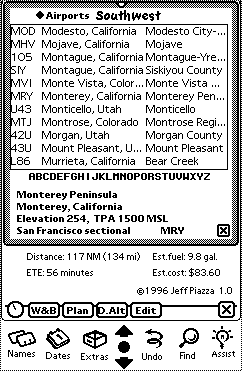
Some of Newton Aviator's key features include:
Newton Aviator comes with a complete database of U.S. public-use airports, divided into seven regions (matching the organization of the Airport/Facilities Directory). You can load as many or as few of these regions onto your Newton as you wish. Using more regions gives you more airports to choose from, but requires more memory.
Airports are listed alphabetically by city name. The Newton's "Find" feature can also be used to search for an airport by name -- particularly useful when the airport name doesn't match the name of the city.
As you can see, each airport entry lists the airport name, city name, elevation, traffic pattern altitude, identifier, and sectional chart. More importantly, each airport includes latitude and longitude information that's automatically used for flight planning.

In addition to using the built-in database of U.S. public-use airports, you can now create and maintain your own database of airports, including private or non-U.S. airports.
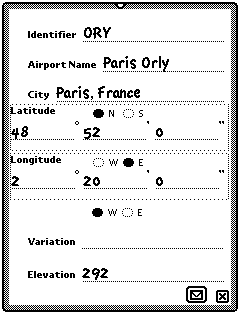
While Newton Aviator uses U.S. standard units by default, non-U.S. pilots may prefer to select metric units as appropriate.
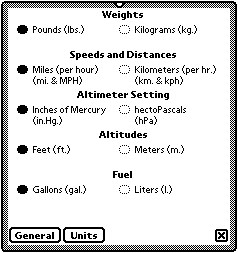
Enter Specifications for Your Aircraft
Newton Aviator lets you maintain a database for each aircraft, and aircraft type, you fly. For an aircraft type, you enter the details of the C.G. envelope for each approved operations category (normal, utility, aerobatic), and the location and arm for each seat, fuel tank, and cargo space. (This takes all of fifteen minutes with your Newton and the pilot's operating handbook.) You may also enter information about true airspeed, average fuel flow, etc.
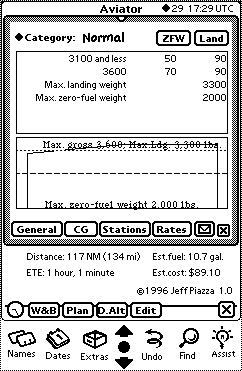
For each aircraft you fly, you enter (once) the type, basic empty weight, and empty C.G. arm. Then, for each flight, a few taps lets you enter the manifest for that flight (passengers, cargo, and fuel). Newton Aviator lets you enter passengers by name, and remembers the weights you've entered for your most frequent passengers, so you don't have to keep asking them their weight (which wouldn't improve your popularity, certainly).
The loading screen only shows the stations which your aircraft has -- the aircraft pictured, for example, doesn't have a nose baggage compartment, so none is pictured, but another type of aircraft might.
Many aircraft can be operated in more than one category (normal category or utility category, for example). Newton Aviator lets you specify both C.G. envelopes, and choose which envelope you want to work with for a particular flight.
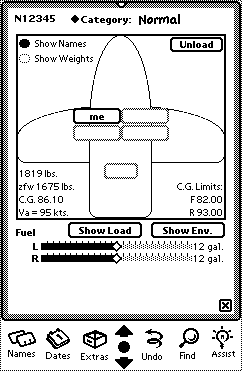
With the cabin manifest entered, you can switch to the C.G. envelope view to determine not just whether you're within limits, but how close to the edge you are. Newton Aviator will warn you if you're out of bounds or overweight (including whether you exceed the zero fuel weight or landing weight, if your aircraft has restrictions on these) for the operation category selected.

Briefers hate it when you call up and give a flight plan out of sequence. Get some respect (and cooperation) by having your information in front of you, in the order the briefer expects it, with Newton Aviator's Flight Plan screen. (Notice that Newton Aviator assigns the correct equipment suffix, home base, and color ,based on information you've entered about this aircraft; and figures true airspeed, time enroute, fuel on board, and number aboard based on your flight planning information.) For greater convenience and flexibility, you can annotate the other flight plan fields on the screen, including route of flight, remarks, and contact info -- no more fumbling with scraps of paper in the phone booth.
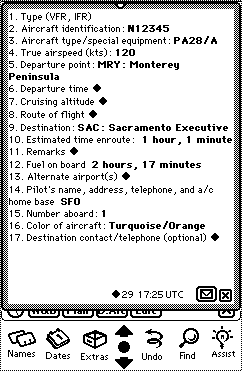
Forget about pressure altitude and resetting your altimeter: with Newton Aviator, just read your indicated altitude off the altimeter, the setting from the Kohlsman window, and the outside air temperature from a thermometer, then get your density altitude from Newton Aviator. Enter your calibrated airspeed and read off your true airspeed. What could be simpler? (Sorry, the Newton is not an approved electronic calculator for taking your written test.)
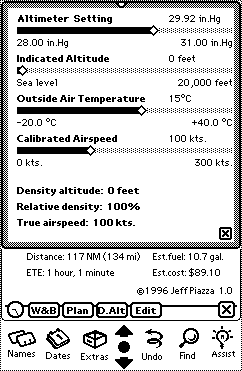
Zulu Time, and Sunset and Sunrise Times
Newton Aviator's main screen and flight planning screen both show the current UTC time (with date), continuously updated. Tapping on the UTC display opens a conversion chart between local and zulu time, with the current hour specially marked. Also shown are sunrise and sunset information for your current location.
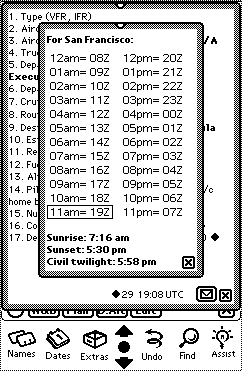
If you regularly fly more than one aircraft, sometimes remembering details about each aircraft can be a challenge. Which aircraft has the cover that's difficult to remove? Which one has the nice radios? Newton Aviator lets you keep your own notes and records on each N-number in your private aircraft records, including color, weight, fuel flow, operating cost (rental rate), equipment and radios, and arbitrary notes.
